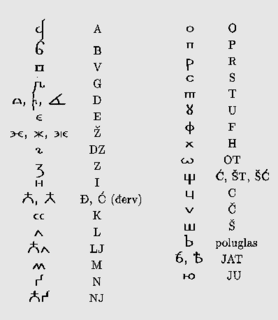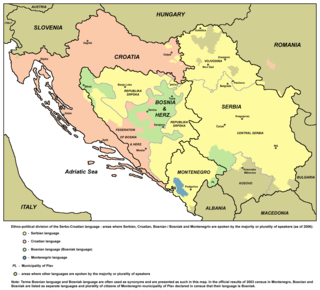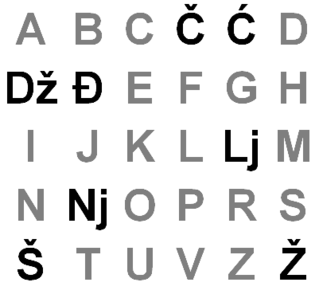 W
WThe Bosnian language is the standardized variety of Serbo-Croatian mainly used by ethnic Bosniaks. Bosnian is one of three such varieties considered official languages of Bosnia and Herzegovina, along with Croatian and Serbian. It is also an officially recognized minority language in Croatia, Serbia, Montenegro, North Macedonia and Kosovo.
 W
WArebica is a Bosniak variant of the Arabic script used to write the Bosnian language. It was used mainly between the 15th and 19th centuries and is frequently categorized as part of Aljamiado literature. Before World War I there were unsuccessful efforts by Bosnian Muslims to adopt Arebica as the third official alphabet for Bosnian alongside Latin and Cyrillic.
 W
WBosnian Cyrillic, widely known as Bosančica is an extinct variant of the Cyrillic alphabet that originated in medieval Bosnia. The term was coined at the end of the 19th century by Ćiro Truhelka. It was widely used in modern-day Bosnia and Herzegovina and the bordering areas of modern-day Croatia. Its name in Bosnian-Croatian-Serbian is Bosančica and Bosanica the latter of which can be translated as Bosnian script. Serb scholars call it Serbian script, Serbian–Bosnian script, Bosnian–Serb Cyrillic, as part of variant of Serbian Cyrillic and the term "bosančica" according to them is Austro-Hungarian propaganda. Croat scholars also call it Croatian script, Croatian–Bosnian script, Bosnian–Croat Cyrillic, harvacko pismo, arvatica or Western Cyrillic. For other names of Bosnian Cyrillic, see below.
 W
WStandard Bosnian, Croatian, Montenegrin, and Serbian are different national variants and official registers of the pluricentric Serbo-Croatian language.
 W
WThe Declaration on the Common Language was issued in 2017 by a group of intellectuals and NGOs from Croatia, Bosnia and Herzegovina, Montenegro, and Serbia who were working under the banner of a project called "Language and Nationalism". The Declaration states that Croats, Bosniaks, Serbs and Montenegrins have a common standard language of the polycentric type.
 W
WDržavna Tajna is a book by Semir Halilović, son of Bosnian general Sefer Halilović, published in 2005. The book has the tagline "STROGO POVJERLJIVO"
 W
WThe Eastern Herzegovinian dialect is the most widespread subdialect of the Shtokavian dialect of Serbo-Croatian, both by territory and the number of speakers. It is the dialectal basis for all modern literary Serbo-Croatian standards: Bosnian, Croatian, Serbian, and Montenegrin.
 W
WGaj's Latin alphabet is the form of the Latin script used for writing Serbo-Croatian and all of its standard varieties: Bosnian, Croatian, Serbian, and Montenegrin.
 W
WMuhamed Hevaji Uskufi Bosnevi was a Bosnian poet and writer who used the Arebica script.